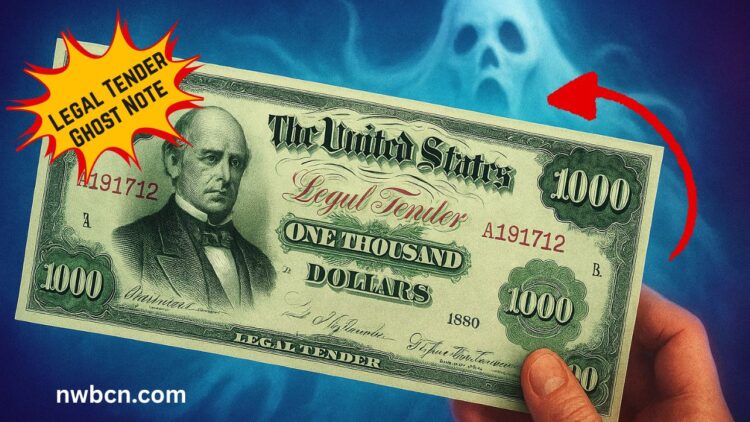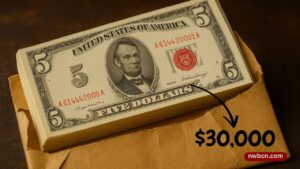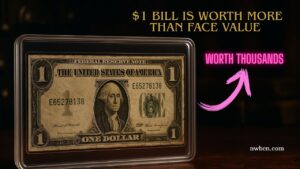In 1880, the United States issued large-size Legal Tender Notes in denominations ranging from $1 to $10,000. Among these, the $1,000 note from Series 1880 is one of the rarest and most iconic “ghost” bills, with only five known survivors in existence.
Thought to have vanished almost entirely, each surviving note today is a prized centerpiece of private, museum, or Federal Reserve collections. The phenomenon of its disappearance and reappearance makes it a fascinating study in numismatic rarity.
Origins: The 1880 Legal Tender Series
- Introduction: Legal Tender Notes of 1880 were part of the Fourth Issue under the Legal Tender Acts, authorized for denominations from $1 to $10,000.
- Design: Elaborate engraved portraits with ornate borders; the $1,000 featured a female allegorical figure.
- Purpose: Issued in the post–Civil War era to replace earlier currency and accommodate industrial expansion.
Why the $1,000 Note Became a Ghost
- Limited Issue and Survival
- Only a tiny number were printed—most were redeemed, withdrawn, and destroyed via Treasury procedures.
- Age and Wear
- High-denomination notes were often bank-held and saw heavy circulation or were destroyed for security.
- Collectors vs. Banks
- Many notes were absorbed into vaults or private collections without being tracked—almost forgotten.
Known Survivors & Where They Reside
| Location | Holder | Census Status |
|---|---|---|
| Smithsonian Institution | Public archives | 1 note in collection |
| Federal Reserve Bank of N.Y. | Official Reserve archives | 1 note |
| Private Collector A | Owned and loaned to Stack’s Bowers | 1 note |
| Private Collector B | Graded PMG/PCGS, occasionally displayed | 1 note |
| Private Collector C | Auctioned (2010s), occasionally appears | 1 note |
Five known pieces make any sighting or auction highly newsworthy.
Auction Record: $252,000 Sale in 2023
- In August 2023, Stack’s Bowers Galleries sold a Series 1880 $1,000 note (Fr. 187k) for $252,000.
- Classified as “Very Fine”, this represents one of the highest auction prices ever recorded for this note.
- With only five known survivors, each graded note holds immense collector value.
Value Spectrum: What These Notes Fetch
| Condition | Value Range (USD) | Rarity & Notes |
|---|---|---|
| Very Fine (VF) | $50,000–$150,000 | Most available survivor grades |
| Extremely Fine (XF) | $150,000–$300,000+ | Rare mid-grade survivors |
| Choice Unc (CU–MS62) | $300,000–$500,000+ | Extremely rare; few examples |
| Proof or Specimen | N/A | Likely only in archives; none on market |
The $252,000 sale reflects a mid-tier “VF” price, though higher-grade specimens could potentially fetch up to $500,000+.
Market Drivers: Why It Commands Such Value
- Scarcity: Only five known notes in existence.
- Condition rarity: Most survivors are low-grade; higher grades are nearly nonexistent.
- Provenance and pedigree: Smithsonian or N.Y. Fed holdings add credibility and value.
- Collector prestige: Owning one places a collector in an elite, near-mythical category.
Highlights from 1880 Legal Tender Notes
| Denomination | Known Survivors | Notable Auction Price |
|---|---|---|
| $1,000 | ~5 known | $252,000 (2023 VF) |
| $50 | ~12 known | $9,500 (2010s PMG Fine, eBay) |
| $10 | Dozens | $4,695 (Fr. 107 PMG CU64 EPQ) |
| $1 | Hundreds | Up to $8,750 in PMG Gem Unc |
| $1,000 | 5 known | $252,000 recorded sale |
Why Many Have Disappeared
- Treasury redemptions post–1880s drove most notes out of circulation.
- High-value targets for destruction—precious metal bullion drove banks to cancel them.
- Limited tracking: Prior to modern census efforts, many disappeared from records.
How Collectors Can Find One
- Check auction listings at top firms (Stack’s Bowers, Heritage).
- Look for PMG/PCGS-certified examples with pedigree documentation.
- Follow institutional deaccessions, as rarely banks or museums might release a note.
Preservation & Care
- Store in inert currency sleeves or encapsulated PMG/PCGS holders.
- Keep in climate-controlled, secure storage.
- Record and preserve provenance documentation, including grading reports and archival ties.
The 1880 $1,000 Legal Tender note truly is a “ghost”: nearly erased from history and with only five examples left. Its recent $252,000 sale reflects not just value—but its survival against time.
As the rarest of the rare in American paper currency, each sighting reshapes our understanding of numismatic legacy.
FAQs
Q1: Are 1880 $1,000 notes still legal tender today?
Yes—they remain legal tender, but their collector value far exceeds their $1,000 face value.
Q2: Why did most of these notes vanish?
They were redeemed/destroyed by Treasury after the 1880s and many were unrecorded prior to census efforts.
Q3: Could more turn up in the future?
Unlikely—only five notes are known, all tracked. Any new discovery would be a major numismatic event.




